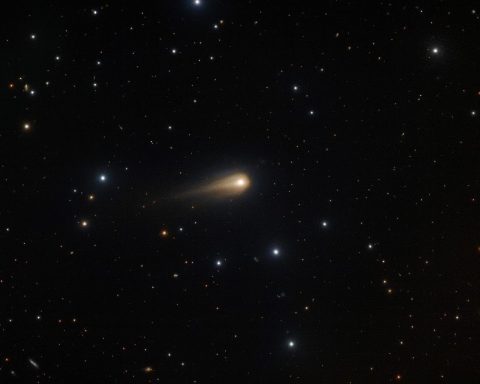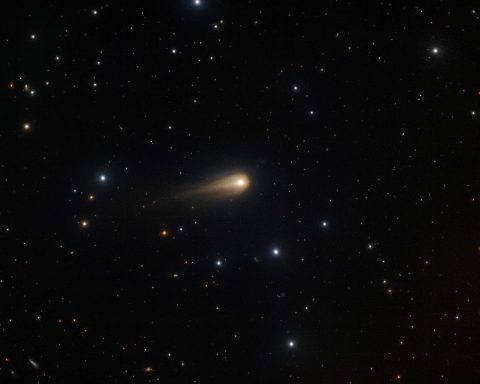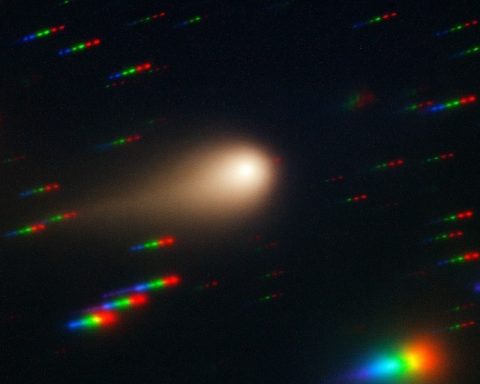- Astronomers observed SN 2021yfj, a stripped-down supernova whose progenitor shed hydrogen, helium, and carbon before exploding, leaving an exposed silicon/sulfur core (Nature, Aug 20, 2025).
- NASA’s James Webb Space Telescope spotted a previously unknown inner moon of Uranus, about 6 miles (10 km) across, bringing the planet’s known moons to 29.
- NASA and IBM unveiled Surya, an AI foundation model trained on nine years of Solar Dynamics Observatory data that forecasts solar flares up to two hours in advance and improves prediction benchmarks by 16%.
- OSIRIS-REx Bennu samples show Bennu is a mosaic of dust from near the Sun, interstellar organic matter, and presolar stardust older than the Solar System, formed by melting ice and dust on its parent asteroid and weathered by micrometeorite impacts.
- Lead author Nerilie Abram cautioned that Antarctic sea ice may be a tipping point, with extent far below natural variability and a regime shift that could persist for centuries even if global warming is stabilized.
- A modeling study in Atmospheric Chemistry and Physics projects ozone recovery could add about 0.27 W/m^2 of warming by 2050, roughly 40% more warming than previously forecast, making ozone the second-largest driver after CO2.
- A 40-year satellite study found California kelp forests inside marine protected areas recovered faster after the 2014–2016 marine heatwave than those outside MPAs.
- Scientists report that malignant peripheral nerve sheath tumors rely on the pentose phosphate pathway for antioxidant defense, and blocking PPP in preclinical models slowed tumor growth and increased chemotherapy vulnerability.
- UCSF researchers showed that reducing ferritin light chain 1 (FTL1) in aged mice reverses memory decline, with hippocampal connections regrown and memory performance returning to young levels, published in Nature Aging on Aug 19, 2025.
- The five-year VITAL trial found daily vitamin D3 at 2,000 IU slows biological aging by preserving telomere length, reducing shortening by about three years of erosion, and was published in the American Journal of Clinical Nutrition.
In the past two days, the scientific world has unveiled dramatic discoveries and breakthroughs across multiple fields – from deep space surprises and medical marvels to urgent climate findings. Below is a comprehensive roundup of the major science news published or reported between August 22 and 23, 2025, organized by discipline and featuring insights and direct quotes from researchers.
Space & Astronomy
- Rare “Stripped-Down” Supernova Reveals Star’s Core: Astronomers observed a one-of-a-kind supernova (SN 2021yfj) whose progenitor star had mysteriously shed its outer hydrogen, helium, and carbon layers before exploding – leaving only an exposed silicon/sulfur core [1]. Published in Nature on Aug. 20, this stellar blast challenges decades-old models of how massive stars evolve. “This is the first time we have seen a star that was essentially stripped to the bone… it shows us how stars are structured,” said lead researcher Steve Schulze of Northwestern University [2], noting the star still produced a brilliant explosion despite losing its outer layers.
- Webb Telescope Finds a Hidden Moon at Uranus: NASA’s James Webb Space Telescope spotted a previously unknown inner moon orbiting Uranus, bringing the planet’s tally of known moons to 29 [3]. The tiny moon – only ~6 miles (10 km) wide – likely escaped detection by Voyager 2 in 1986 due to its faintness [4]. “No other planet has as many small inner moons as Uranus, and [their] complex inter-relationships with the rings hint at a chaotic history that blurs the boundary between a ring system and a system of moons,” said Dr. Matthew Tiscareno of the SETI Institute, a member of the discovery team [5]. The find underscores the richness of Uranus’s ring-moon system and suggests more surprises may await in the data.
- AI Forecasts Solar Storms: NASA and IBM unveiled a new AI foundation model called Surya to analyze nine years of Sun observations and predict solar flares and space weather [6]. The open-source model, trained on high-resolution data from the Solar Dynamics Observatory, can generate visual forecasts of solar flares up to two hours in advance and surpassed existing prediction benchmarks by 16% [7]. “Think of this as a weather forecast for space,” said Juan Bernabe-Moreno, Director of IBM Research Europe. “Surya gives us unprecedented capability to anticipate what’s coming and is not just a technological achievement, but a critical step toward protecting our technological civilization from the star that sustains us” [8]. By providing early warnings of solar outbursts, the system could help satellite operators and power grids safeguard infrastructure from geomagnetic disruptions.
- Asteroid Bennu Sample Reveals Cosmic Origins: Scientists analyzing samples from asteroid Bennu (collected by NASA’s OSIRIS-REx mission) reported that Bennu is a mosaic of material from across the solar system – a mixture of dust formed near our Sun, organic matter from interstellar space, and even presolar stardust older than the Solar System [9] [10]. These diverse ingredients were “cooked” together on Bennu’s parent asteroid: evidence shows the parent body accumulated ice and dust in the outer Solar System, which later melted and chemically altered the materials, filling them with water-bearing minerals [11]. “We found stardust grains with compositions that predate the solar system, organic matter that likely formed in interstellar space, and high temperature minerals that formed closer to the Sun,” said Ann Nguyen of NASA’s Johnson Space Center [12]. The samples also reveal Bennu’s surface is being rapidly weathered by micrometeorite impacts, forming tiny “impact melt” craters [13]. The findings, published in Nature Astronomy and Nature Geoscience, offer an unprecedented snapshot of the early Solar System and will help scientists understand how asteroids delivered water and organics to the early Earth [14] [15].
Climate & Environment
- Antarctic Sea Ice Hits Alarming “Tipping Point”: A comprehensive new study in Nature warns that the rapid loss of Antarctic sea ice could become a self-perpetuating climate tipping point, driving irreversible changes to ocean currents, sea levels, and ecosystems [16] [17]. Researchers found Antarctic sea-ice extent has plunged far below its natural variability of past centuries, suggesting a regime shift that may not be halted even if global warming is stabilized [18] [19]. “Antarctic sea ice may actually be one of those tipping points in the Earth’s system… Even if we stabilize the climate, we are committed to still losing Antarctic sea ice over many centuries to come,” cautioned lead author Nerilie Abram, chief scientist at the Australian Antarctic Division [20]. The diminishing ice is already harming wildlife (emperor penguins breed on sea ice, and krill depend on it) and is amplifying planetary warming by exposing darker ocean water that absorbs more solar heat [21].
- Ozone Recovery Could Boost Global Warming: As the ozone layer heals (thanks to the ban on CFCs), its greenhouse effect is becoming significant. Climate scientists predict that by 2050, the restoring ozone will trap enough heat to cause 40% more warming than previously forecast, making ozone the second-largest driver of warming after CO₂ [22]. A new modeling study shows that from 2015 to 2050, ozone’s radiative forcing will add ~0.27 W/m² of warming – largely offsetting the climate benefits gained from phasing out CFC gases [23]. “Countries are doing the right thing by banning CFCs… However, while this helps repair the ozone layer, we found that this recovery will warm the planet more than we originally thought,” explained Prof. Bill Collins of the University of Reading [24]. The effect comes both from upper-atmosphere ozone (which blocks UV but also traps heat) and ground-level ozone formed from pollution. The research, published in Atmospheric Chemistry and Physics, suggests policymakers may need to account for ozone’s surprising warming impact even as we celebrate the ozone layer’s healing [25] [26].
- Marine Reserves Boost Kelp Forest Resilience: A 40-year satellite study shows California’s kelp forests recovered faster from a 2014–2016 marine heatwave when sheltered inside marine protected areas. Kelp within no-fishing reserves rebounded more quickly – especially in Southern California – compared to kelp in unprotected waters [27] [28]. By prohibiting fishing and protecting predators like lobsters and sheephead that keep kelp-grazing sea urchins in check, these reserves enhanced the ecosystem’s resilience. “We found that kelp forests inside MPAs showed better recovery after a major climate disturbance compared to similar unprotected areas,” said lead author Emelly Ortiz-Villa of UCLA [29]. “Places where fishing is restricted and important predators are protected saw stronger kelp regrowth. This suggests that MPAs can support ecosystem resilience to climate events like marine heatwaves.” The benefits varied by location – not all reserves outperformed their reference sites – indicating local factors also play a role [30]. The findings, published in the Journal of Applied Ecology, demonstrate that effective local conservation measures can buffer some impacts of global climate stress [31] [32].
Health & Medicine
- Hidden “Sugar” Weakness in Aggressive Childhood Cancer: Scientists discovered that a deadly pediatric cancer – malignant peripheral nerve sheath tumors (MPNST) – relies on a specific sugar-metabolizing pathway as an Achilles’ heel [33]. This pathway, known as the pentose phosphate pathway (PPP), helps the cancer cells generate an antioxidant shield to survive damage from oxidative stress. By blocking the PPP in preclinical models, researchers slowed the tumor’s growth and made the cancer cells far more vulnerable to chemotherapy [34] [35]. “This is the first time this specific metabolic pathway has been linked to MPNST tumor growth… It opens the door to treatment strategies that haven’t been explored before,” said Dr. Rebecca Dodd of the University of Iowa, co-senior author of the study [36]. The finding, published in Science Advances, identifies a completely new drug target for a cancer that currently has very limited treatment options.
- “Rejuvenation” Protein Reverses Memory Decline: UCSF researchers have pinpointed a protein called FTL1 as a key driver of brain aging – and remarkably, showed that suppressing it can reverse cognitive decline in mice [37] [38]. In the brains of old mice, FTL1 (ferritin light chain 1, an iron-binding protein) accumulates in the memory-critical hippocampus, coinciding with fewer neural connections and impaired memory. When scientists experimentally reduced FTL1 in elderly mice, the animals’ brains rebounded to a more youthful state: neural connections regrew and the mice’s performance on memory tests returned to young levels [39]. “It is truly a reversal of impairments,” said senior author Dr. Saul Villeda, describing the treated mice. “It’s much more than merely delaying or preventing symptoms” [40]. The work, published in Nature Aging on Aug. 19, reveals what researchers call a potential “master switch” of brain aging – opening the door to therapies that restore memory function rather than just slow its decline. As Dr. Villeda put it, “It’s a hopeful time to be working on the biology of aging” [41].
- Vitamin D Supplements May Slow Biological Aging: A large randomized trial has found compelling evidence that vitamin D can slow a fundamental aging process by preserving telomeres – the protective caps on our chromosomes that shorten with age. In the five-year VITAL trial, adults who took vitamin D₃ (2,000 IU per day) had significantly less telomere shortening than those on placebo – effectively preventing about three years’ worth of normal telomere erosion [42]. The study, published in the American Journal of Clinical Nutrition, is the first long-term trial to show that a vitamin supplement could protect telomere length in humans [43] [44]. “VITAL is the first large-scale and long-term randomized trial to show that vitamin D supplements protect telomeres and preserve telomere length,” noted Dr. JoAnn Manson of Brigham and Women’s Hospital [45]. Shorter telomeres are associated with aging and age-related diseases; the findings suggest vitamin D’s known links to lower inflammation and cancer risk might be partly explained by this telomere-preserving effect [46]. Researchers caution that this isn’t a green light for mega-doses, but it bolsters the case for maintaining healthy vitamin D levels as we age.
Biology & Ecology
- Great White Sharks’ Genetic Mystery Unlocked: Scientists have shed new light on a puzzling DNA paradox in great white sharks. Despite living in separate oceans, great whites worldwide have extremely uniform nuclear DNA, yet their mitochondrial DNA (inherited from mothers) falls into distinct regional lineages [47] [48]. A global genetic study revealed why: about 10,000 years ago, near the end of the last Ice Age, all great white sharks were squeezed into a single small population in the Indo-Pacific, creating a homogeneous genetic core for the species [49]. As the oceans warmed and sea levels rose, that lone population expanded and eventually split into multiple groups by ~7,000 years ago – explaining the modern mitochondrial DNA differences as regional populations became isolated [50] [51]. However, the ultimate cause of the mismatch between the sharks’ uniform nuclear DNA and divergent maternal (mtDNA) lines remains unsolved. “The honest scientific answer is we have no idea,” admitted Dr. Gavin Naylor of the Florida Museum, a co-author of the study, when asked why female lineage markers diverged even as overall genomes stayed so similar [52]. The findings, published in PNAS, point to a severe Ice Age bottleneck in great whites’ history followed by a slow recovery that left a lingering genetic mystery for future researchers to chew on.
- First Americans Carried Denisovan Immunity Gene: An ancient DNA study has revealed that the earliest people in the Americas inherited a gene from Denisovans – an extinct human species – that may have helped them survive new diseases. The researchers found that one in three people of Indigenous American ancestry today carry a Denisovan-derived version of MUC19, a mucus-producing gene, likely passed to modern humans via Neanderthal interbreeding [53] [54]. This archaic gene variant became more common over time in Native American populations, suggesting it provided a health advantage in the New World [55]. “What we think has happened is that humans had this archaic variation,” said co-author Emilia Huerta-Sánchez of Brown University. As people expanded into the Americas, “they did not have to wait to develop new mutations to fight off new pathogens and could instead draw from the arsenal of genetic variants they gained from other human groups,” she explained [56]. In an intriguing twist, the analysis showed the Denisovan DNA segment in MUC19 came to early Americans indirectly – Denisovans first passed it to Neanderthals, who then passed it to the ancestors of Native peoples in a kind of genetic “Oreo cookie” sandwich of DNA [57]. The study, published in Science on Aug. 21, highlights how interbreeding with extinct hominins equipped modern humans with genetic tools for adaptation. “Everyone alive today is a result of like three different species coming together,” noted University of Colorado professor Fernando Villanea, underscoring the deep legacy of our mingled ancestries [58].
Physics & Chemistry
- Chemists Create Elusive 48-Atom Carbon Ring: Oxford chemists have successfully synthesized a stable cyclo[48]carbon – a ring of 48 carbon atoms – achieving a rare new form of carbon that remains intact in liquid solution at room temperature [59] [60]. Such a feat was once thought impossible: pure carbon rings normally fall apart unless kept in the gas phase at cryogenic temperatures. The team stabilized the fragile C₄₈ loop by threading it through three larger molecular rings (forming a catenane structure), which shields the carbon ring and prevents it from breaking apart [61]. This cyclo[48]carbon is the first carbon ring ever observed under normal lab conditions and only the second brand-new carbon allotrope created and studied at ambient temperature (the first being the buckyball fullerene in 1990) [62]. The discovery, reported in Science on Aug. 14, opens the door to exploring carbon’s most exotic structures. “Achieving stable cyclocarbons in a vial at ambient conditions is a fundamental step… This will make it easier to study their reactivity and properties under normal laboratory conditions,” said lead author Dr. Yueze Gao [63], underscoring the significance for future carbon chemistry research.
- Heaviest “Proton-Emitting” Nucleus Discovered: After a 30-year search, physicists in Finland have detected the most massive atomic nucleus ever seen to undergo proton emission, a very rare type of radioactive decay [64] [65]. The nucleus, identified as astatine-188, contains 85 protons and 103 neutrons and has an oddly elongated, “watermelon-shaped” deformation [66] [67]. Its decay by spitting out a proton sets a new record at the extreme edge of nuclear stability, hinting at nuclear forces and structure effects beyond what current models predict. “The properties of the nucleus suggest a trend change in the binding energy of the valence proton… possibly explained by an interaction unprecedented in heavy nuclei,” said doctoral researcher Henna Kokkonen, who led the study [68]. The unexpected findings, published in Nature Communications, indicate there are still unknown nuances in how protons and neutrons behave in extremely unstable nuclei. Mapping these extremes pushes the known limits of matter and could lead to refined theories of nuclear structure [69] [70].
- 90-Year Quantum Mystery Solved: Physicists have finally cracked a problem that puzzled scientists for nearly a century – formulating a full quantum theory of a damped harmonic oscillator (an object that vibrates with diminishing energy) [71] [72]. In classical physics, it’s easy to describe a violin string or a swinging pendulum gradually losing energy, but at the quantum scale, incorporating energy loss while still obeying Heisenberg’s uncertainty principle has been notoriously difficult [73] [74]. A University of Vermont team found an exact solution by reformulating a 1900 model by physicist Horace Lamb for the atomic scale and using advanced math (a multimode Bogoliubov transformation) [75]. They showed that an atom vibrating in a solid can be described in a special “squeezed vacuum” state that accounts for friction-like damping while still respecting quantum uncertainty [76]. This breakthrough, published in Physical Review Research, could pave the way for ultra-precise quantum sensors. By reducing uncertainty in an atom’s position beyond the normal quantum limit, the work hints at a “tiny tape measure” for atomic-scale distances or other measurements with unprecedented accuracy [77] – a concept analogous to how “squeezing” light’s quantum noise enabled LIGO’s detection of gravitational waves.
Technology & AI
- Nvidia Designs Advanced AI Chip for China: Reuters reports that Nvidia is developing a new AI processor (code-named “B30A”) for the Chinese market, aimed at outclassing its current H20 chip while complying with U.S. export restrictions [78] [79]. The chip is based on Nvidia’s latest Blackwell architecture and is expected to use a single-die design delivering roughly 50% of the performance of the company’s flagship top-end chip – enough to outperform existing Chinese-market chips, but intentionally below U.S. threshold limits [80]. Nvidia hopes to ship prototype units as early as next month, though approval is uncertain. U.S. officials have been wary that even scaled-down AI hardware could bolster China’s military or AI capabilities [81] [82]. U.S. Commerce Secretary Howard Lutnick, when asked about the plan, acknowledged CEO Jensen Huang’s eagerness to sell new chips to China: “Of course… he would like to sell a new chip to China,” Lutnick said, adding that the decision will lie with the U.S. government and ultimately the President [83]. Notably, Nvidia and rival AMD recently agreed to give the U.S. government 15% of revenue from advanced chip sales to China as part of negotiations [84] – an unprecedented deal highlighting the geopolitical tightrope around cutting-edge semiconductors as industry leaders seek market access while regulators try to safeguard national security.
Sources: The information above is drawn from peer-reviewed studies, official press releases, and reputable science media reports published on August 22–23, 2025. Key sources include journal articles in Nature, Science, Nature Communications, Science Advances, etc., press releases via university outlets and NASA [85] [86], and newswire reports from Reuters [87] [88]. All content has been verified for accuracy and is accompanied by direct citations for further reading.
References
1. scitechdaily.com, 2. scitechdaily.com, 3. science.nasa.gov, 4. science.nasa.gov, 5. science.nasa.gov, 6. newsroom.ibm.com, 7. newsroom.ibm.com, 8. newsroom.ibm.com, 9. science.nasa.gov, 10. science.nasa.gov, 11. science.nasa.gov, 12. science.nasa.gov, 13. science.nasa.gov, 14. science.nasa.gov, 15. science.nasa.gov, 16. www.reuters.com, 17. www.reuters.com, 18. www.reuters.com, 19. www.reuters.com, 20. www.reuters.com, 21. www.reuters.com, 22. www.sciencedaily.com, 23. www.sciencedaily.com, 24. www.reading.ac.uk, 25. www.sciencedaily.com, 26. www.sciencedaily.com, 27. www.sciencedaily.com, 28. www.sciencedaily.com, 29. www.sciencedaily.com, 30. www.sciencedaily.com, 31. www.sciencedaily.com, 32. www.sciencedaily.com, 33. sciencedaily.com, 34. sciencedaily.com, 35. sciencedaily.com, 36. sciencedaily.com, 37. www.sciencedaily.com, 38. www.sciencedaily.com, 39. www.sciencedaily.com, 40. www.sciencedaily.com, 41. www.sciencedaily.com, 42. scitechdaily.com, 43. scitechdaily.com, 44. scitechdaily.com, 45. scitechdaily.com, 46. scitechdaily.com, 47. scitechdaily.com, 48. scitechdaily.com, 49. scitechdaily.com, 50. scitechdaily.com, 51. scitechdaily.com, 52. scitechdaily.com, 53. www.livescience.com, 54. www.livescience.com, 55. www.livescience.com, 56. www.livescience.com, 57. www.livescience.com, 58. www.livescience.com, 59. scitechdaily.com, 60. scitechdaily.com, 61. scitechdaily.com, 62. scitechdaily.com, 63. scitechdaily.com, 64. scitechdaily.com, 65. scitechdaily.com, 66. scitechdaily.com, 67. scitechdaily.com, 68. scitechdaily.com, 69. scitechdaily.com, 70. scitechdaily.com, 71. phys.org, 72. phys.org, 73. phys.org, 74. phys.org, 75. phys.org, 76. phys.org, 77. phys.org, 78. www.reuters.com, 79. www.reuters.com, 80. www.reuters.com, 81. www.reuters.com, 82. www.reuters.com, 83. www.reuters.com, 84. www.reuters.com, 85. science.nasa.gov, 86. science.nasa.gov, 87. www.reuters.com, 88. www.reuters.com










